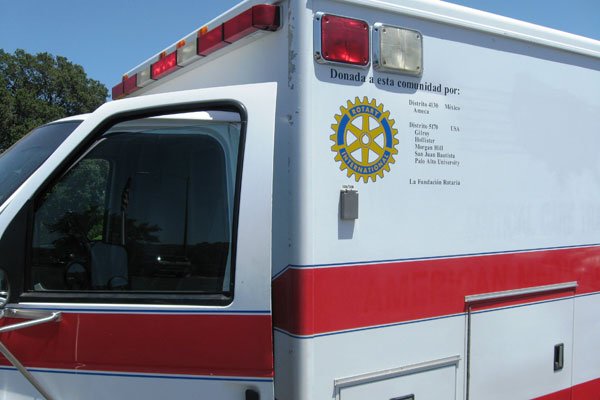Gilroy Rotary hosted Ameca, Mexico’s Rotary representatives
Tuesday. The Ameca club was here to accept the gift of an
ambulance, which is part of the local Rotary Club’s International
project. The Ameca Club’s representatives drove the ambulance to
Mexico, where it will
&
amp;#8194;be used by the Red Cross to help with much needed
medical services in their local community.
Gilroy Rotary hosts Mexican counterpart
Gilroy Rotary hosted Ameca, Mexico’s Rotary representatives Tuesday. The Ameca club was here to accept the gift of an ambulance, which is part of the local Rotary Club’s International project. The Ameca Club’s representatives drove the ambulance to Mexico, where it will be used by the Red Cross to help with much needed medical services in their local community.
While here in Gilroy, the Ameca Club will be visiting Gilroy Gardens, Goldsmith Seeds, and the Gilroy Outlets. They will also be hosted by the Morgan Hill, Hollister and San Juan Bautista clubs.
Water district approves sharing cost of mussel inspection program
The Santa Clara Valley Water District Board of Directors agreed to help fund Santa Clara County’s mandatory boat inspection program at local reservoirs. This inspection program is necessary to prevent invasive zebra and quagga mussels from getting into the water through recreational boating.
The total cost of the program is $560,000, which the water district and the county are splitting equally. The inspections began Friday. The reservoirs which will be opened are Anderson, Calero, Coyote and Stevens Creek. To offset the county’s costs of the inspection program, boaters will be asked to pay a $7 fee per inspection or they can purchase a $35 annual inspection pass. To learn more about the actual inspection process, boaters should visit the county’s Web site www.sccgov.org and look under the quick clicks section.
The spread of zebra and quagga mussels has created enormous problems in other parts of the country and the state. As a result, park authorities throughout the state have implemented detailed boating inspection programs at more than 22 reservoirs.
The invasive mussels are commonly transported by recreational boats. Bay Area boaters often frequent a number of reservoirs, which means the chance of the mussels spreading is significant.
Since the discovery of quagga mussels in southern California last year, and zebra mussels at San Justo Reservoir in San Benito County in January this year, the water district has worked closely with the California Department of Fish and Game, Santa Clara County Parks and other Bay Area water agencies to monitor the reservoirs and evaluate protective measures against the introduction of mussels from boating.
Details:











